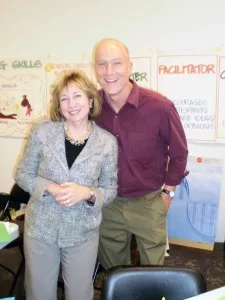ParCenTra Public Offering
Participants Report: Delightful, Fun, Challenging, and Transformative
Recently, we did a public offering in the Kala Arts Institute Berkeley for a diverse group of participants.
The two-day workshop was filled with creativity and delight. The art institute created an inspiring learning environment. We walked through an art gallery to reach our workshop space and moved some print equipment to expand our space. A show called ‘Systems of Collecting’ was on display.
We saw a sample array of artist Mari Andrews’ vast collection of elements from nature and whimsical sculptures she created from them. It was a metaphor for the training. Using the skills they brought and those they acquired, each participant sculpted their own 20-minute training masterpiece – something they planned to use in their work. They felt they were “transformed by the process”.
Participant Centered Training (PCT)
We spent two days creating together an inclusive and engaging learning environment in which the genius of all the participants was sparked. We learned that all participants wanted to make a difference in the world and were committed to learning new skills to support the changes they envisioned.
In Participant Centered Training, learning is never one-way; there is an exchange among everyone involved, so everyone learned from one another in unexpectedly rich ways. This resonated with and supported one of our key points – how to engage participants as partners in the learning.
A wide range of participants found it useful.

We had a variety range of participants, for example an environmental artist who works with youth, a consultant working for a sophisticated financial consulting firm, a professional curriculum developer, an architect. By the end of the second day, they were all applying PCT tools in their area of expertise.
To give you an idea: one of the participants, a curriculum developer, presented an innovative, participatory design concept applied to what she said was ordinarily a boring topic – writing precise, viable learning goals. She designed and facilitated a brief PCT training module. In less than 20 minutes, each participant not only learned the characteristics of a viable goal, but had fun setting relevant personal learning goals for themselves.
In participant centered training, you gain actual skills e.g. how to coordinate activities, how to build short transitions between each training section, how to expand your own skill set by applying the new skills to your own short presentation, and by participating in practice sessions led by the trainers and by other participants.
Challenging, and fun

Several participants said that it was a challenging and fulfilling assignment to create and lead a 20-minute learning segment. This practicum required applying new principles and practices. Participants found an entirely new point of view about their role in creating learning experiences for others. People said it was a transformative experience.
Participants reported that the exercises and the design of the training was fun as well as challenging. One said the training challenged her to pull out the skills necessary to create a presentation – which she didn’t know she had before. It was a delightful surprise for many participants that we all can be engaging trainers.
Warm-ups – applying brain science to transitions.
People learned the difference between an icebreaker and a warm up. A warm-up is designed to simulate relevant brain activity as well as to built trust in the group. Participants practiced designing warmups and immediately used them in their own presentations.
One participant reported – in follow-up – that she had “designed a warm up in the training about social networks that proved to be so powerful that I have been using it with my clients. It has had a profound effect every single time. It gives participants an authentic experience of a network.”
We can all be first rate trainers

We all have skills, expertise, and life experience that others can learn from. PCT provided a framework for participants to see clearly their own skills and to appreciate them fully. In the process participants started understanding and filling in gaps in their skill sets. One participant realized she was jumping from one topic to another without proper support for learners. She reorganized her content and designed something short and sweet as transitions for each section. Participants stayed engaged through out her training.
Participant Centered Training is designed to help participants see and appreciate what they are good at as well as identify their gaps. They can then skillfully develop and integrate what needs more attention. As a result, each participant designed and offered a compelling and transformative training.
We would love to see you at our next public offering.
Mary Ann Gallagher & Myan Baker




